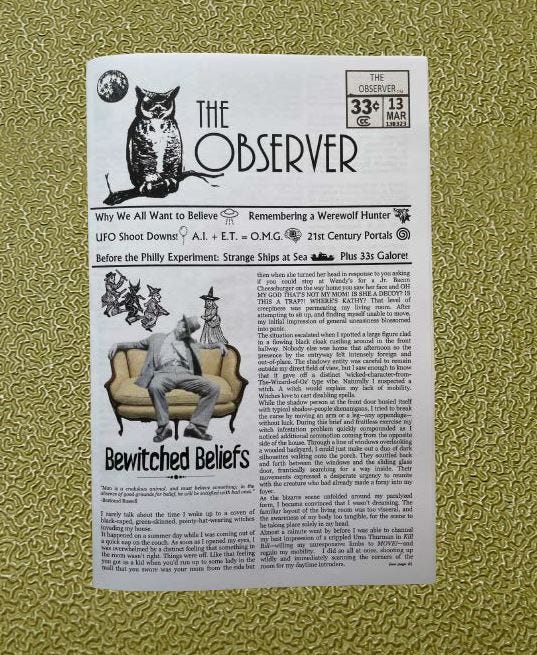ET's Trap or a UFO's Crash?
As Congress preps for this week's Wacky Wednesday, The Observer's voice of reason, Michael H. Hoffman, considers various UFO crash scenarios.
by Michael Harris Hoffman - firstcontact@ufoegghead.com
Stories about crashed UFOs found with the remains of apparent extraterrestrial crew on board date back to at least the 1940s. These stories gained new traction in June 2023 with whistleblower reports that such ships—a lot of them—have been retrieved by the U.S. government, and the truth of their existence withheld from Congress, the nation, and the world. Assuming the accuracy of such accounts, we have to rely on modern Ufological folklore for details until the process of voluntary or involuntary disclosure reveals more.
To prepare psychologically and intellectually for the day that verified official accounts do get out, we should get to work using the stories at hand to formulate scenarios that may explain what’s behind these events. Here are five to consider. They rely on available UFO folklore, and employ terrestrial historical experience for frames of reference moored in reality as we know it.
ET’s Trap?
An experiment. When new technologies are introduced in a culture, they might transform that society with a force that affects the entire world. Consider the Meiji Restoration of the late 19th and early 20th century that transformed Japan into a modern industrial state and global player with stunning speed.
In that light, consider whether seeding this planet with extraterrestrial technology, delivered in the guise of crashed UFOs, could be an experiment, or ploy, to see how we stack up as quick learners compared to other emerging star-faring worlds. Perhaps ET see quick learning as a plus to bring candidate worlds into an interstellar community. Or perhaps they see quick learning as an early warning of a threat-world that must be contained.
The ET who Never Were. The ancient terrestrial art of military deception may have extraterrestrial counter- parts. Let’s consider the master deception achieved in World War II and immortalized in the book and movie entitled The Man Who Never Was. In 1943 British intelligence dressed a man who had died of natural causes as a Royal Marine officer, complete with fake military documents revealing bogus invasion plans. His remains were set adrift to be found off the coast of Spain and delivered to local authorities. The plan worked. German intelligence obtained the plans. Based on those papers they diverted forces away from Sicily, weakening German defenses there before the Allies invaded the island.
If ET remains have been found with crashed UFOs, we should consider that they may have been planted to achieve similar effects. They may not even be the remains of ET from the same civilization that launched the UFOs toward Earth. The question would then be what purpose or desired effect they were looking for.
A UFO’s Crash?
UFO pioneers. Following World War One, the U.S. Post Office took a lead role as a world pioneer in civil aviation. Aviators were hired to deliver airmail across the U.S. They flew with little or no experience with cross-country flying, in bad weather, sometimes at night, and with little in the way of aids to navigation. The service flew from 1918-1926 and there was a heavy toll—35 pilots died delivering the mail. Some UFOs and crew may visit here under conditions as uncertain for them as aviation was for flight pioneers on this planet.
From our perspective, UFOs traveling here from other worlds are inherently advanced. It may all be relative. Newcomers to interplanetary exploration may cut a swath on less technologically- advanced worlds, but they could in effect be piloting flying machines equivalent in interplanetary sophistication with the bi-planes that thrilled spectators on Earth a century ago. If there have been a large number of UFO crashes and retrievals, all or most seemingly related to just one or two of the “models” spotted among the varied UFOs seen in our skies through history, they may constitute de facto memorials to interstellar UFO pioneers who perished here during their early, tentative, and technologically awkward explorations out into the cosmos.
Viking funerals. Some crashed UFOs may be other than de facto memorials. That may be their actual purpose. Burial at sea has been an honored practice since antiquity. The famed Viking funeral boats offer a striking example. See the closing scene from the cinematic classic The Vikings (1958). Ashes are, now, respectfully spread by plane as well, and sometimes launched into outer space.
Consider that extraterrestrials may occasionally launch UFOs to crash to earth, carrying deceased crew aboard in the same way that Vikings would sometimes cast-off burning ships in funerial tribute. The prospective down side in exposing UFO technology to primitive societies is, perhaps, considered minimal by ET and less important than paying tribute to crew members who perish in space. An honorable last journey to the surface of a far-off world.
A high-risk planet. We all know that mariners and aviators face many risks. Reminders of the risks they face from weather, hazards to navigation, and hostile military encounters appear in the news all the time. Reports relating to crashed UFOs suggest that such hazards sometimes bring down extraterrestrial craft as well.
Interplanetary civilizations may recognize that there’s a greater magnitude of risk for visitors going to some planets than others. Atmospheric conditions and weather are rougher on some worlds than others. Uncongenial populations that pose actual danger to visiting spacecraft and crew are more of a risk on some inhabited worlds than others. High risk planets. Especially hazardous duty visiting worlds that present all these dangers. A planet like Earth for instance.
Posed UFO crashes may be a guise for unknown extraterrestrial agendas. Or UFO crashes may be just what they seem; namely, unplanned endings for extraterrestrial spacecraft lost, in many ways, on risky missions to this planet for unknown purposes good, bad, or both. Talk is emerging of the great benefits that would be derived by openly sharing scientific knowledge with the world about the material and technological characteristics of such vehicles. There would also seem some urgency to share knowledge about them, widely, for another reason-in order to foster creative efforts to figure out why they are even here.











